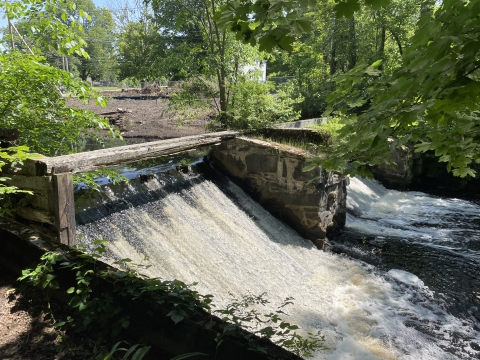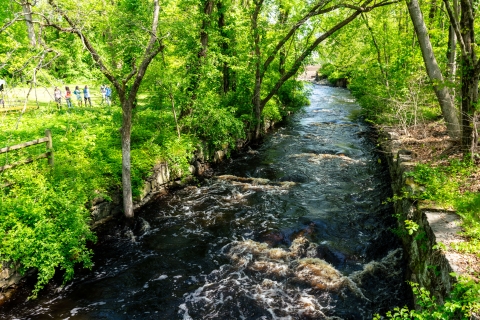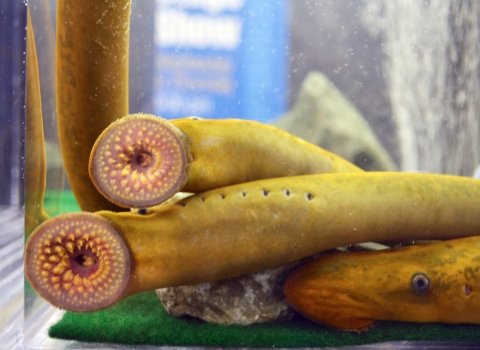The last time migratory fish swam freely between Rhode Island’s Narragansett Bay and Lake Nippenicket in Bridgewater, Massachusetts, Woodrow Wilson was president and women couldn’t yet vote. It was high time for a change.
Until 2023, the High Street Dam stood as the first barrier to migratory fish on the Town River, but thanks to efforts by many partners, the dam is gone. Fish coming from Narragansett Bay, up the Taunton River, and into the Town River can now more easily reach historical spawning and rearing grounds upstream.
The $9-million project, which included replacing the nearby High Street Bridge, also made the Bridgewater community more resilient to climate change climate change
Climate change includes both global warming driven by human-induced emissions of greenhouse gases and the resulting large-scale shifts in weather patterns. Though there have been previous periods of climatic change, since the mid-20th century humans have had an unprecedented impact on Earth's climate system and caused change on a global scale.
Learn more about climate change . It was partially funded by the Bipartisan Infrastructure Law Bipartisan Infrastructure Law
The Bipartisan Infrastructure Law (BIL) is a once-in-a-generation investment in the nation’s infrastructure and economic competitiveness. We were directly appropriated $455 million over five years in BIL funds for programs related to the President’s America the Beautiful initiative.
Learn more about Bipartisan Infrastructure Law through the U.S. Fish and Wildlife Service’s National Fish Passage Program.
Will rivers run silver again?
For eons, alewife and blueback herring — known collectively as river herring — have switched addresses with the seasons, swimming up coastal rivers to spawn each spring and returning to the sea in late summer. By linking ocean and inland ecosystems, they enrich both, supporting biodiversity and the livelihoods and recreational pursuits of many.
There was a time when rivers ran silver with migratory fish each spring. But by the late 20th century, degraded habitat, increased fishing pressure in international waters, and uncontrolled incidental catch by commercial fishermen — along with dams built to power mills — caused a dramatic drop in their populations throughout New England.
In the early 2000s, Massachusetts banned the harvest of river herring in state waterways, and the National Marine Fisheries Service named both alewife and blueback herring as Species of Concern.
Removing obsolete dams alone isn’t enough to save river herring and other migratory fish, but it’s a crucial step. Without the ability to migrate from the ocean to inland waterways, alewife, blueback herring and American shad can’t access important reproductive habitat, and American eel and sea lamprey can’t reach upstream areas where they mature.
The 40-mile Taunton River — a federally designated National Wild and Scenic River — is the longest undammed coastal river in New England, emptying into Narragansett Bay. But several of its tributaries, like the Town River, have dams blocking fish passage fish passage
Fish passage is the ability of fish or other aquatic species to move freely throughout their life to find food, reproduce, and complete their natural migration cycles. Millions of barriers to fish passage across the country are fragmenting habitat and leading to species declines. The U.S. Fish and Wildlife Service's National Fish Passage Program is working to reconnect watersheds to benefit both wildlife and people.
Learn more about fish passage . Over the last decade, both public and private conservation groups, including the Service, have addressed barriers to migratory fish throughout the Taunton watershed.
In the 2010s, partners removed three dams on the Mill River in the city of Taunton and built a fishway at the outlet of Lake Sabbatia, its headwaters. The work reconnected 30 river miles and 560 lake acres of spawning and rearing habitat with the larger Taunton River and Narragansett Bay system. Migratory fish responded enthusiastically. Five years after the last dam was removed, nearly 36,000 river herring reached Lake Sabbatia — a ten-fold increase!
“Water quality and instream habitat also improved, as did water and sediment flows,” said Alison Bowden, director of conservation science and strategy with The Nature Conservancy in Massachusetts. “These data show the impact of watershed-scale collaboration on restoration efforts and are informing ... work in the region to reduce risks to communities and improve river health.”
A win-win in Bridgewater
For hundreds of years, High Street Dam powered various iron-producing businesses. Most recently standing 12.5 feet high and 80 feet long, the dam not only blocked natural flows on the Town River but, along with the aging High Street Bridge just upstream, also caused localized flooding. During a March 1968 storm, floodwaters overtopped High Street and reached the nearby Lincoln Athletic Association building.
While the dam had a fish ladder to help migratory fish pass, even the most effective fish ladder is an obstacle to most fish species, and the structure structure
Something temporarily or permanently constructed, built, or placed; and constructed of natural or manufactured parts including, but not limited to, a building, shed, cabin, porch, bridge, walkway, stair steps, sign, landing, platform, dock, rack, fence, telecommunication device, antennae, fish cleaning table, satellite dish/mount, or well head.
Learn more about structure had deteriorated over time. In the early part of this century, an average of 65,000 river herring passed through each year, with a high of 310,000 in 2003. Numbers had declined in recent years.
In 2012, the Massachusetts Division of Marine Fisheries began working with the dam’s owner, APC Corporation, to improve operation of the fish ladder at the dam. In 2015, APC supported a study to evaluate further actions for improving fish passage, with dam removal the preferred outcome.
In addition to dismantling the dam, the feasibility study recommended upgrading the 200-year-old High Street Bridge due to its undersized and aging infrastructure. In summer 2023, the obsolete High Street Dam was removed, and the High Street Bridge was replaced with a structure designed to handle 21st-century weather conditions — and vehicles.
Bridgewater Town Manager Michael Dutton said addressing the dam and the bridge in the same project was a win-win for the town.
“A catastrophic dam failure would have taken out the town’s wastewater treatment plant and part of Bridgewater State University’s campus. And the bridge had been a concern for years. When disparate goals merge, amazing things can happen.”
Getting fish where they need to go ...
With the dam gone and the bridge replaced, migratory fish have easier access to an important 10-mile segment of the Town River that leads to 354-acre Lake Nippenicket.
“Removing the High Street Dam has greatly improved fish passage and overall habitat quality,” said Chris Hirsch, dam removal program manager for the Massachusetts Division of Ecological Restoration. “We’re excited to see the project’s continued benefits and expect this restoration work to translate into larger and more resilient migratory fish populations in the Town River.”
The work also received more than $1.5 million from the federal Bipartisan Infrastructure Law, a once-in-a-generation opportunity to invest in our nation’s rivers, streams and communities. The law included $200 million for the Service’s National Fish Passage Program, which works with partners to remove barriers, restoring aquatic connectivity and habitat for priority species, building safer communities, reducing flood risk, improving recreational opportunities, and generating jobs and business to bolster local economies.
Since 1999, the National Fish Passage Program has worked with more than 2,000 local communities, Tribes, state agencies, watershed groups and private landowners across the country to remove or bypass more than 3,400 barriers to fish passage and reopen access to more than 61,000 miles of upstream habitat for fish and other wildlife.
“The U.S. Fish and Wildlife Service has been proud to be a partner in the High Street dam removal project,” said Cathy Bozek, the National Fish Passage Program coordinator for the Northeast. “Like many fish passage projects, this project restores and reconnects important habitat for many migratory fish species, builds climate resiliency, and boosts economic benefits for the surrounding community.”
A remaining dam with a fish ladder stands between the former High Street Dam site and Lake Nippenicket, at War Memorial Park in West Bridgewater. The town is planning to replace the deteriorating dam with a nature-like fishway, a series of rocks and resting pools that acts as an instream fish ladder.
... and sending floodwaters on their way
Addressing aging and insufficient structures like the High Street dam and bridge makes communities like Bridgewater safer in the face of more severe storms caused by climate change.
Jim Turek, restoration ecologist with the National Oceanic and Atmospheric Administration’s Northeast Restoration Center, explained that in addition to bolstering populations of migratory fish species, dam removals help people who live nearby. “They also reduce the risk of flooding and improve public safety, benefiting local communities both upstream and downstream of dams.”
Free-flowing rivers and bridges that reach from bank to bank without supports can handle heavy rainfall that would otherwise cause flooding. The new 55-foot, clear-span bridge is designed to withstand a 500-year storm and climate change projections through 2070.
A change for the better
On an unusually warm spring day in May 2024, partners and community members gathered in Bridgewater to celebrate the project and its benefits to migratory fish and climate resilience. The waters of the Town River flowed serenely by, on their way to Narragansett Bay, as dignitaries like U.S. Congressman William Keating and U.S. Department of the Interior Assistant Secretary for Fish and Wildlife and Parks Shannon Estenoz spoke.
Acting as master of ceremonies, Town Manager Dutton stressed the importance of honoring history while acknowledging that change is inevitable.
“We’re more educated about how to treat our migratory fish populations; we’re more educated about the impacts of a changing climate; and we’re more educated about how we design our infrastructure to accommodate Mother Nature and leave a lighter human footprint,” he said.
Partners hope more migratory fish will pass this spot each year, on a journey old as time, steadily building their populations. Meanwhile, the new bridge will embrace would-be floodwaters, sending them safely downstream.
In addition to the Bipartisan Infrastructure Law, the High Street dam removal and bridge upgrade was supported by:
- Massachusetts Executive Office of Energy and Environmental Affairs
- Massachusetts Division of Ecological Restoration
- Town of Bridgewater
- National Oceanic and Atmospheric Administration
- The Nature Conservancy in Massachusetts
- National Fish and Wildlife Foundation
- APC Corporation
- Taunton River Stewardship Council










